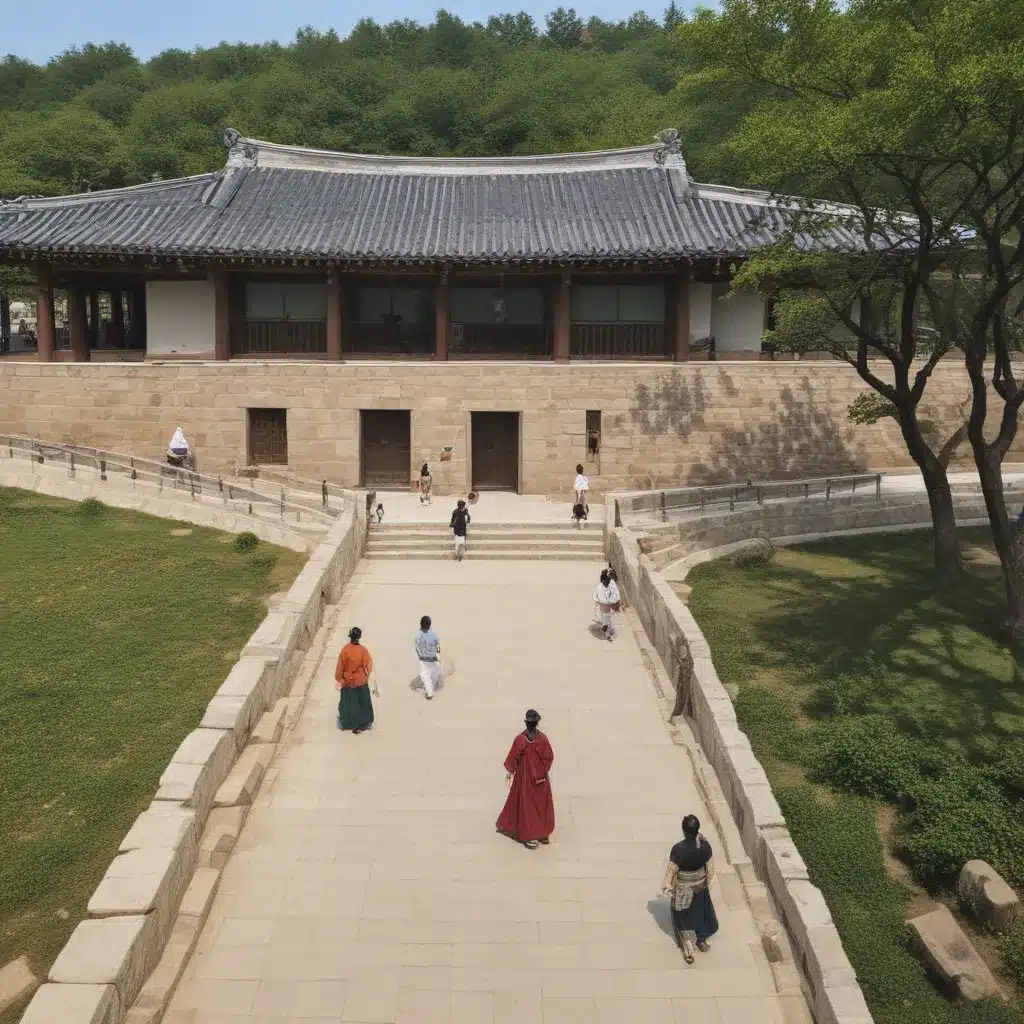
Uncovering the Heartbeat of Korean Culture
As I stepped through the grand entrance of the National Folk Museum of Korea, I felt a palpable sense of anticipation. This wasn’t just another museum – it was a gateway into the rich tapestry of Korean history and tradition. Little did I know that the journey that lay ahead would captivate my senses and leave an indelible mark on my understanding of this fascinating country.
Embracing the Past, Shaping the Future
The museum’s exterior, adorned with traditional Korean architectural elements, immediately set the tone for the experience to come. I couldn’t help but be drawn in by the intricate details and the way they seamlessly blended with the modern surroundings. It was as if the building itself was a living, breathing embodiment of Korea’s past and present.
The National Folk Museum of Korea is situated on the grounds of the Gyeongbokgung Palace, one of the most iconic landmarks in Seoul. As I strolled through the serene gardens, I couldn’t help but feel a deep connection to the history that permeated every inch of this place. The museum’s strategic location only added to the sense of immersion, transporting me back in time with each step.
Unveiling the Tapestry of Korean Culture
Once inside, the museum’s vast collection of artifacts and exhibits unfurled before me, like the unraveling of a magnificent tapestry. From traditional clothing and household items to intricate handicrafts and agricultural tools, every object told a story – a testament to the ingenuity, resilience, and cultural richness of the Korean people.
The museum’s three main galleries – the Permanent Exhibition Hall, the Special Exhibition Hall, and the Outdoor Exhibition Hall – each offered a unique perspective on Korean heritage. As I wandered through the meticulously curated displays, I found myself transported to different eras, immersed in the rhythms of daily life, and captivated by the intricate details that brought the past to life.
Discovering the Rhythm of Korean Traditions
One of the highlights of my visit was the chance to witness traditional Korean performances. In the Outdoor Exhibition Hall, I stumbled upon a mesmerizing display of Talchum, a masked dance-drama that dates back centuries. The vibrant costumes, the captivating choreography, and the powerful drumbeats created an electrifying atmosphere that left me spellbound.
As I watched the performers weave their enchanting tales, I couldn’t help but marvel at the enduring legacy of Korean traditions. These cultural expressions, passed down through generations, were not merely historical artifacts – they were living, breathing manifestations of the soul of the Korean people.
Immersing in the Rhythms of Daily Life
But the museum’s true magic lay in its ability to transport me into the everyday lives of Koreans throughout history. In the Permanent Exhibition Hall, I explored meticulously recreated scenes of traditional homes, workshops, and village life. The attention to detail was astounding, and I found myself lost in the rhythms of daily tasks, from the intricate process of making pottery to the communal gatherings around the fire.
One exhibit that particularly captivated me was the traditional Korean kitchen, complete with the iconic ondol floor heating system and the distinctive brass cookware. As I stood there, imagining the scents and sounds of a bustling household, I couldn’t help but feel a deep sense of connection to the people who had once occupied these spaces.
Uncovering the Diversity of Korean Culture
As I delved deeper into the museum’s offerings, I was struck by the sheer breadth and diversity of Korean culture. From the intricate embroidery of traditional hanbok dresses to the delicate craftsmanship of celadon pottery, each exhibit showcased the remarkable artistry and ingenuity of the Korean people.
What particularly impressed me was the museum’s ability to weave together the diverse strands of Korean identity, highlighting the regional variations and the rich tapestry of traditions that have shaped the nation over time. Whether it was the vibrant folk art of Gangwon-do or the distinctive agricultural practices of Jeju Island, every aspect of the museum’s collection offered a window into the multifaceted nature of Korean culture.
Connecting with the Present
As I delved deeper into the museum’s exhibits, I couldn’t help but be struck by the ways in which the past and present were inextricably linked. The museum’s contemporary programming, which includes rotating special exhibitions and educational initiatives, underscored the enduring relevance of Korean cultural heritage.
One such program that caught my eye was the museum’s collaboration with local artisans and designers, showcasing how traditional craftsmanship is being reimagined for the modern era. It was a powerful reminder that the National Folk Museum of Korea is not merely a static repository of the past, but a dynamic platform for celebrating the evolution and adaptation of Korean culture.
Leaving with a Deeper Understanding
As I reluctantly bid farewell to the National Folk Museum of Korea, I couldn’t help but feel a profound sense of gratitude for the experience. This wasn’t just a museum visit – it was a journey into the very heart and soul of Korea, a place where the past and present seamlessly converge.
The insights I gained, the emotions I felt, and the connections I made will undoubtedly linger long after I’ve left. The National Folk Museum of Korea has left an indelible mark on my understanding of this remarkable country, and I know that I will return, again and again, to uncover new layers of its rich cultural tapestry.

